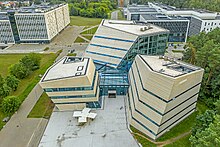Vilnius University Library
VU Library holds 5.4 million documents on shelves measuring 166 kilometres (103 mi) in length.
The holdings, accessible to members of the university and wider public, include some of the oldest manuscripts, incunabula and engravings in Lithuania and Eastern Europe.
The core of the library consisted of the collections of the Grand Duke of Lithuania and King of Poland Sigismund Augustus and suffragan bishop of Vilnius Georg Albinius.
The library of Sigismund Augustus contained the best of classical works, travelogues, historical books, chronicles, and literature on natural science, law, military, and medicine published in the 16th century.
After the Third Partition of the Polish–Lithuanian Commonwealth in 1795, the greater portion of the Grand Duchy of Lithuania, including its capital Vilnius, became part of the Russian Empire.
A Lending Department was opened in 1815, and university staff and students, officials of the educational districts, and gymnasium teachers were allowed to borrow books.
At the end of the 1960s a decision was made to safeguard integral collections from various donors in the main library depository.
On 1 December 2001 a user service sub-system enabling placing a request for an item via electronic catalogue from any study space equipped with computer was introduced in the library.
In 2005 an information centre "Odysseus" for people with disabilities was opened for the first time in the history of Lithuanian academic libraries.
On 26 March 2009 a tripartite agreement was signed between the Ministry of Education and Science of the Republic of Lithuania, the Central Project Management Centre and Vilnius University on financing and management of new Vilnius University Library building “National Open Access Scholarly Communication and Information Centre” (SCIC).
Besides traditional services, the library offers users some unconventional ones such as booking of study spaces or premises, guided tours or 3D printing.
The library's holdings contain the largest collections of incunabula (328 items, one of the earliest incunabula is Roberto Valturio De re military (Concerning Military Matters, Verona, 1472), one of the largest collections of post-incunabula (around 1.7 thousand items) in Lithuania and the richest in the world collection of early printed Lithuanian books (including the first printed Lithuanian book by Martynas Mažvydas, Katekizmas by Mikalojus Daukša, works by Baltramiejus Vilentas); especially valuable old atlases (1.2 thousand items) and maps (around 10 thousand items); book collection of the Old Vilnius University Library – Bibliotheca Academiae Vilnensis (it includes books from collections of Sigismund August, Sapieha family, Georg Albinius, Walerian Protasewicz, Michał Kazimierz Pac, Eustachy Wołowicz, university professors and eminent figures of Lithuania).
The painter adhered to the spirit of Classicism; between the windows and on the walls he painted the portraits of the 12 most prominent figures in antique art and science: Socrates, Plutarch, Pindar, Anacreon, Hesiod, Heraclitus, Aristotle, Euripides, Diogenes, Homer, Archimedes and Plato.
[2] Over time hall's functions changed and in 1867 painter Vasilii Griaznov replaced its classical tones with pseudo-Byzantine ornamentation.
Since then the Hall of Franciszek Smuglewicz has retained its appearance with furniture from the time of the Public Library of Vilnius.
For a long time the third floor was home to the Art Department, and the workplace of famous artist Jan Rustem.
In 1929, professor Joachim Lelewel bequeathed a valuable collection of books and atlases to the library; they were transferred from Kurniki to this hall, which was then named in his honour and commemorative exhibition was arranged.
The observatory was designed and built by Lithuanian architect and astronomer, VU professor, Tomasz Zebrowski.
Funds for the building were donated by Ignacy Ogiński and his daughter Elżbieta Ogińska-Puzynina, whose particularly generous contribution of 200,000 Polish złoty gained her the title of the observatory patron.
Six massive Baroque pillars, girded with ornamental cornices divide the White Hall into three parts.
Diana holds a portrait of benefactress Elżbieta Ogińska-Puzynina, while Uriana has a wreath of stars in her hands.
The White Hall contained not only astronomical equipment but also a valuable library with works on astronomy, mathematics, physics, geography, architecture, and other subjects taught at the university.
Now it houses the Professor's Reading Room and plans are made to arrange a museum of the university's history.
The 17th-century vaults have been preserved, but their decorations of plaster-work were painted over at the beginning of the 20th century, and now the room is devoid of embellishments.
The Scholarly Communication and Information Centre (SCIC) is a subdivision of Vilnius University Library situated in the Saulėtekis Science and Technologies Valley.
Underground storage and technical floors have modern book transportation, security and fire extinguisher with mist spay systems.





